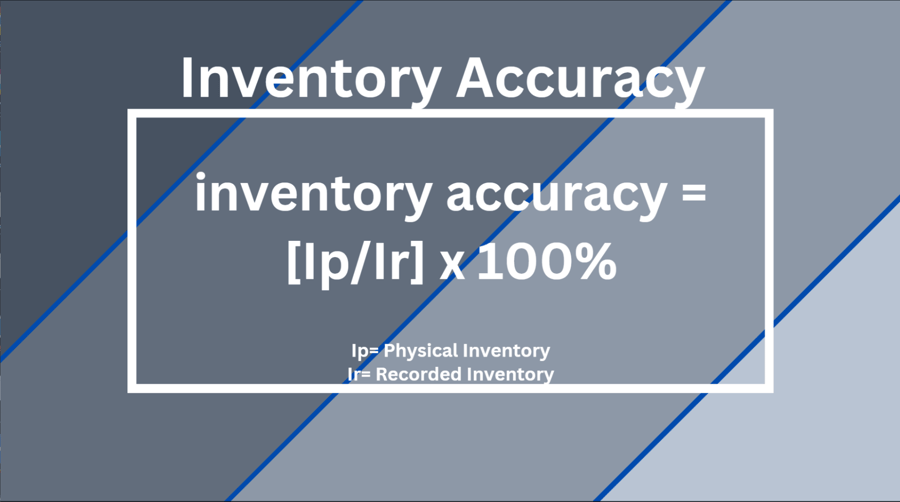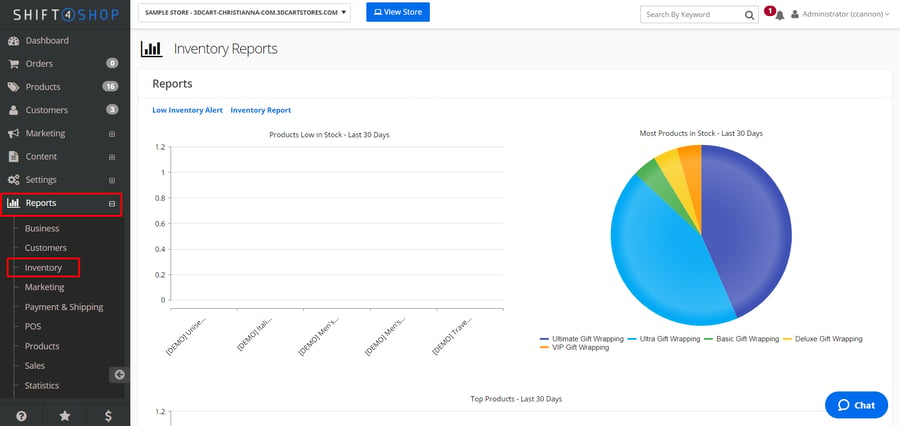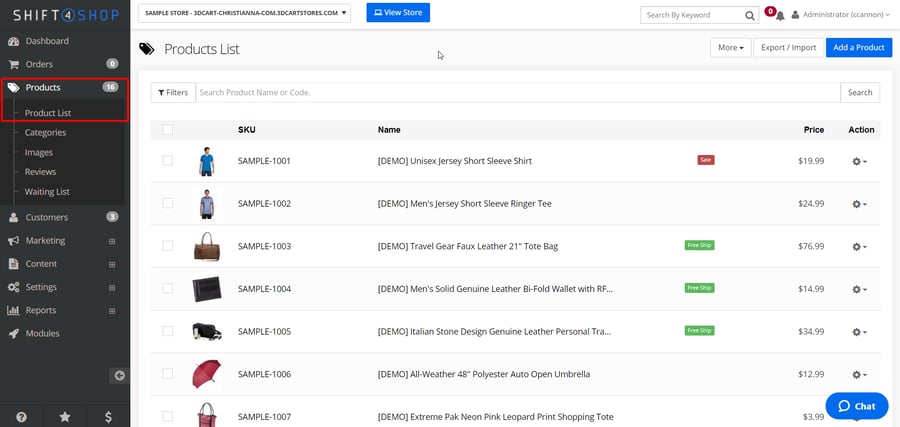
If you work in retail or eCommerce, inventory is the lifeblood of your company. You also carefully pick the best people and recruit top talent to ensure areas like order fulfillment operate as smoothly as possible.
Unfortunately, part of being human is making mistakes. Even elite employees will occasionally miscount, misplace, or damage inventory during regular job duties, resulting in a significant loss of time and money.
As operating costs rise and markets evolve, you need every competitive edge to grow. This is where increasing inventory accuracy comes in, as a way to improve efficiency and as an untapped source of organizational growth.
What is Inventory Accuracy?
Any eCommerce business will have two important metrics when dealing with inventory. Those numbers are the stock totals on record and stock levels from physical counting. Inventory accuracy represents the alignment or distance between the two.
Inventory accuracy is obtained from the following equation:

Image created by writer
Businesses calculate inventory accuracy to identify loss through shrinkage and other factors such as data entry errors. Inventory accuracy also helps quantify your organization's current inventory management and control practices.
While 100% accuracy is nearly impossible to achieve, tracking your inventory accuracy percentage gives a baseline for measuring the effectiveness of process improvements.
Inventory accuracy used to be compiled via written counts and spreadsheets. Today, this vital inventory management metric is usually updated in real time by the use of inventory management software.
Why Inventory Accuracy Matters
In business, you want monetary and asset reporting to be as accurate as possible. It’s just a simple necessity of proper accounting. That said, there are many other reasons that high inventory accuracy is essential to any business.
1. Enhanced Customer Satisfaction and Loyalty
Improved inventory accuracy helps reduce human error from data entry and mis-scanning items. For example, with an inventory management solution, your online store will better align with your actual inventory. So when a customer makes an order, fulfillment proceeds without delay or disappointment.
A smooth, positive fulfillment process helps to guarantee rapid shipping and delivery of purchases. Your customers will be impressed and reward you with their loyalty by returning to your eCommerce store in the future.
2. Improved Operational Efficiency
Inventory accuracy depends on several elements, including a warehouse organized for efficiency. For example, uniform bins and pallets will keep identical items together. This helps ensure that warehouse sections are divided according to priority and need so that pickers can quickly get to your best sellers.
Additionally, barcode scanners and radio frequency identification (RFID) systems further eliminate human error while processing deliveries and picking orders. That means your team saves time from having to backtrack due to mistakes.
The right accounting app or an inventory management tool can also be a great asset, as they let your teams manage stock on the go. They also allow you to generate purchase orders and handle invoices during fulfillment. With better operational efficiency for processes like warehousing and fulfillment, your team can concentrate on more important areas.
3. Waste Reduction
Stockouts are the enemy of a positive customer experience. Whilst overstocking is the enemy of your bottom line. Inventory accuracy solutions help prevent the stockpiling of expiring, obsolete, and less popular products.
When items sit around in the dark depths of your warehouse, they take up valuable space and balloon your operating footprint. Not to mention, with solutions like outsourced distribution and third-party logistics (3PL), overstocks incur exponentially increasing carrying costs.
Inventory accuracy tools will notify management of possible overstocks and products with short shelf lives. Armed with foresight, your marketing team can use promotions and discounts to move stock and recoup as much money as possible.
4. Regulatory Compliance
Depending on your business model, you will need to meet various compliance requirements. Every business will need to fully comply with financial reporting regulations for valuations and tax purposes. With improved inventory accuracy, your quarterly and annual accounting reports will be more precise and strong enough to stand up to the heaviest of audits.
Inventory management controls such as barcode scanning help improve the traceability of your products.
These inventory solutions allow you to track every product in real time, from the supplier to the customer. Live updates on where your stock is located are great for operational efficiency. On top of that, for industries such as food, drink, pharmaceuticals, or automotive parts, traceability is mandatory for regulatory compliance.
Stock traceability will also help your business comply with requirements for importing, exporting, quality control, and health and safety.
5. Informs Decision Making

With better inventory accuracy, you will have dependable modeling capabilities that inform decision-makers on what to shift and when to restock. You won’t have to worry about failing to meet seasonal demands or losing customers to stockouts of your hottest products.
Inventory accuracy solutions also help paint a clear understanding of how your business operates. With inventory tracking, you can better identify inefficiencies and bottlenecks in your logistics and warehouse operations.
Strategies for Achieving and Maintaining Inventory Accuracy
With the right tactics, improving and managing your inventory accuracy is easily achievable.
Upskill and educate staff.
With inventory malpractice and mismanagement, the first place to look is in the mirror. What training and policies are currently in place to maximize inventory accuracy?
Depending on your operations, many job titles and staff levels will be handling inventory at one time or another. A simple fix is to first limit who is allowed to handle inventory. Limiting logistics and counts to only the necessary roles reduces mistakes and errors.
For example, only staff that are forklift certified should be allowed to remove or place pallets in the warehouse and on trucks. Only those trained in your item scanning and removal process may pick for order fulfillment.
Besides controlling who has access to inventory processes, you must train your employees to do the job as required. This means onboarding and learning resources for any inventory management platforms as well as procedures like documentation of damaged or missing items.
Upskilling your warehouse and fulfillment teams helps improve the accuracy of your inventory counting. It will also help boost the efficiency and performance of your team.
Implement robust inventory control practices.
There are several inventory control tactics that any business can add to its logistics processes.
1. Warehouse organization is key.

Let’s leave the workplace for a minute. You’re at home and feeling a bit peckish. It’s time to cook some dinner, so you head into the kitchen to start preparing the meal.
You need some chicken, so you head upstairs to the bedroom to grab it from the fridge. You go back downstairs. Now you need some onions and garlic, so you head to the garage. Afterward, you grab a frying pan and oil from a cupboard in the living room.
Sound familiar? Not really, so why would so many businesses set up their warehouses in a likewise disheveled manner?
Get feedback from the stakeholders and use warehouse planning tools to optimize the layout of your distribution centers and storage solutions. This will ensure best sellers are close to the fulfillment areas and complementary products are in logical proximity.
In addition to speeding up picking times, a well-organized warehouse provides a less painful path for inventory counting.
2. Practice inventory labeling.
Properly labeling and naming your inventory is the backbone of fulfillment and counting operations. When combined with inventory management services, labeling and scanning of every item reduces manual workloads and human error.
Implement a labeling system that makes sense for your business. Besides a scannable barcode, information like the product name, type, year, size, and color may be required. Dates received, expiration dates, hazardous materials, and storage instructions are high-priority information for labeling.
Many inventory accuracy tools provide for live tracking of items. So every time a team member scans an item, it is added or removed from your inventory levels. Of course, the caveat is that all warehouse staff must be properly trained on how to use your scanning tools.
3. Use inventory management and ERP solutions.

If you want inventory accuracy that can scale with your business, you will need an inventory management solution. Which software is best for you depends on your business size and industry. Solutions like Shift4Shop give you plenty of options for inventory control and managing stockouts.
A simple inventory tracking system that works hand in hand with scannable barcodes or RFID is a good starting point. Should you desire more robust features like inventory planning, warehousing, and financial reporting, then eCommerce ERP software is the way to go.
An ERP solution will allow your inventory accuracy controls to scale with business growth. They also help you integrate areas like marketing and accounting with your logistics. So, when your warehouse manager flags up an overstock, the marketing team can seamlessly initiate targeted promotions. And with real-time updates, your accounting team can have live numbers for tax calculations and First-In-First-Out (FIFO) or Last-In-First-Out (LIFO).
Conduct regular audits and reconciliations.
As you’ve likely realized, even with the best processes in place, you can’t eliminate the need for physical inventory counts. While this mundane task is often overwhelming and labor-intensive, you can reduce the workload.
1. Use cycle counting.
Many businesses opt for cycle counting of inventory because it slices up work and allows for a more natural inventory count. This method is effectively perpetual counting, but your teams are never conducting full counts. Instead, they focus on one area and move on to the next one at a later date.
Think of cycle counting as a pulse check on your inventory handling. The items being counted are weighed against the levels in the system and calculated for accuracy. If the numbers aren’t within the industry standard of at least 95%, it’s back to the drawing board.
2. Conduct periodic audits.
While cycle counting helps keep an eye on things, complete inventory counts are the only way to get a true snapshot of your current inventory management. Additionally, complete counts are more conducive to the majority of inventory accounting methods.
Full inventory audits can be disruptive unless you have a relatively small inventory. As such, you should decide on a practical frequency of full inventory counts: monthly, quarterly, bi-annually, or annually.
For many organizations, outsourced inventory audits to a third-party solution are the best option. These external auditors will come in and total up the value of your physical stock while your team can continue working as usual (mostly). Once they have a tally, you can compare their numbers against those in your system.
Final Takeaway
Without inventory, eCommerce doesn’t function. Right now, you are losing time and money due to shrinkage and disorganization. There’s no better time than now to implement an improved inventory accuracy strategy.
Set up your warehouse layouts for success. Get leadership and key stakeholders on board with inventory management controls. Find eCommerce and inventory planning solutions that fit your operational needs. Before you know it, you’ll be inching closer to 100% inventory accuracy and reaping the benefits!





Leave a reply or comment below